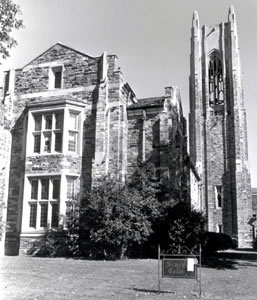
Scarritt College for Christian Workers
Scarritt College was moved from its original home in Kansas City, Missouri, to Nashville in 1923. Established as an institution to train women missionaries by the United Methodist Church, the school was dedicated in 1892 as the Scarritt Bible and Training School. When Scarritt College moved to Nashville to be affiliated with the George Peabody College for Teachers, its Methodist leaders broadened its mission to include both male and female church workers and changed the school’s name to the Scarritt College for Christian Workers. The college was located along Nineteenth Avenue South, adjacent to the Peabody campus, and, like Peabody, the Scarritt campus was distinguished for its architectural beauty. Henry C. Hibbs of Nashville was the primary architect. His Collegiate Gothic design, which used native Tennessee Crab Orchard stone and Indiana limestone in the buildings, is the best example of that architectural style in the capital city and is rivaled in Tennessee only by the campus of Rhodes College in Memphis. Scarritt’s Wrightman Hall, with its 115-foot Gothic tower, was the tallest building in Nashville at the time of its completion and became the campus’s landmark. In 1929 the American Institute of Architects awarded a prestigious Gold Medal to Hibbs for his Scarritt design.
The college prospered in its new setting and by the late 1930s its faculty offered a bachelor’s degree and graduate education in the fields of community and family service, social work, and religious education. After World War II graduate majors in Christian education and church music became available. In the 1950s the Methodists expanded world missionary programs and enrollment at Scarritt increased; over 40 percent of their missionaries trained at Scarritt. In the 1960s, however, Scarritt faced difficult times. In 1973 J. Richard Palmer was brought from Berea College in Kentucky to lead fund-raising and to reverse the college’s dwindling enrollment. Programs in continuing education and women’s studies were strengthened and expanded. Yet Palmer resigned in 1977, frustrated by internal politics and his lack of success in raising even enough money to cover the college’s annual operating expenses.
From 1980 to 1988 the college operated only as the Scarritt Graduate School, offering M.A. degrees in Christian Education and Church Music; the school’s program in religious music continued to be recognized as one of the best in the country. In 1988 the graduate school closed. The Women’s Division of the United Methodist Church reclaimed ownership of the campus and spent several million dollars to renovate buildings. In 1989 the Women’s Division reopened the campus as the Scarritt-Bennett Center of the United Methodist Women’s Division of the Board of Global Missions. The name Bennett honors former president of the Women’s Missionary Council of the Methodist Episcopal Church, South, Belle H. Bennett, who initially urged the creation of a training school for missionaries in 1887.
The Scarritt-Bennett Center is a conference, retreat, and educational center. The Laskey Library is a valuable resource for study in church music; on its second floor is the Hartzler-Towner Multicultural Museum.



